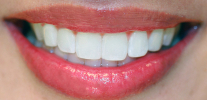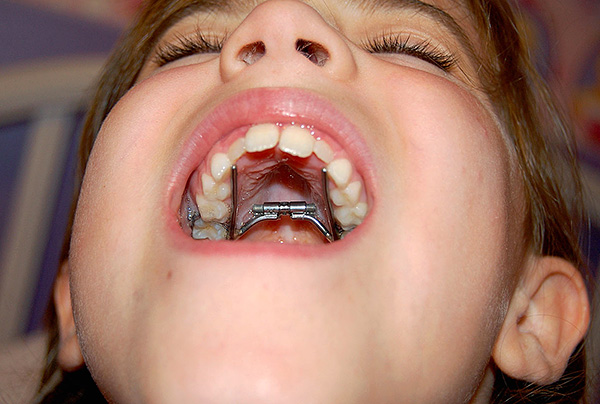
Modern orthodontic treatment is a whole range of activities aimed at normalizing the bite of the patient, both in terms of restoring the full function of chewing, and from an aesthetic point of view. The most important role is played by special devices, which the orthodontist uses to correct the bite.
At the age of 12-14 years old, during the period of occlusion of temporary teeth, as well as their change to permanent ones, doctors use various combinations of removable and non-removable orthodontic appliances, allowing not only to move the teeth to the desired position, but also (most importantly) to expand the size of the jaws baby The need to apply one or another construction depends on the specific type of the patient's bite, and orthodontic appliances are used not only to treat existing abnormalities, but also to prevent the formation of an abnormal bite and to consolidate the results of treatment.
So, let's take a closer look at the devices most often used today in orthodontic practice for bite correction ...
Apparatus for the prevention of the formation of abnormal occlusion in children
Already in infancy, the active formation of the dental system begins - the development and growth of the jaws occurs due to the natural act of sucking. At the same time, there are a number of factors that can have a negative impact on this important process for future bite.
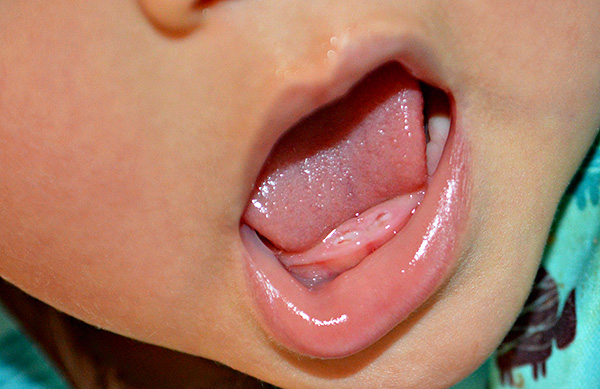
For example, improperly conducted artificial feeding, which, for one reason or another, parents resort to, as well as the child’s sleep mostly on one side only contribute to the occurrence of abnormalities.
To minimize the negative effect of artificial feeding on the development of the dentition of babies, a special orthodontic nipple for a bottle was invented (in fact, this nipple is the simplest orthodontic apparatus for preventing the formation of the wrong bite in the future).
The photo below shows the orthodontic silicone bottle cap:
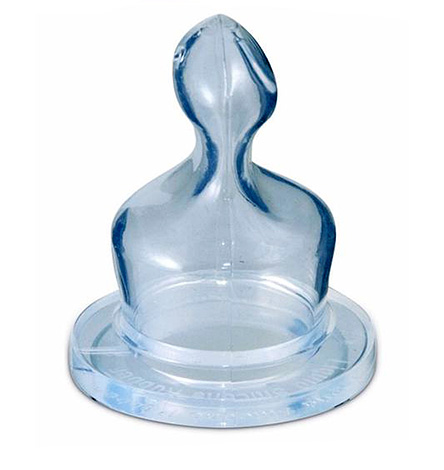
The shape of the product resembles the mother's nipple and creates optimal conditions for convenient feeding and proper sucking (therefore, these nipples are also called anatomical). Nozzles come in different types - depending on the age of the baby and the nature of the food.
Standard sizes:
- 1st - from 0 to 6 months;
- 2nd - from 6 to 18 months;
- 3rd - after 18 months.
Number of holes:
- One - up to 2 months;
- Two holes - age 2 -3 months;
- 4 holes - to reach 6 months of age.
Hole Diameter:
- S is a small hole for liquid food (juice, milk, water);
- M is the middle hole for dry milk mixes;
- L - For feeding dense food (soups, porridges).
From the practice of the orthodontist
It should be borne in mind that the nozzles on the bottle can be made either from latex or from silicone. If an allergic reaction is suspected in response to the use of latex teats, the orthodontist will first recommend a silicone teat. Signs of allergies in the baby are itching, redness of the oral mucosa, anxiety during feeding, refusal of food. As a rule, the tendency to one or another allergic reaction is inherited from parent to child - pay attention to this when choosing a nipple.
Orthodontic pacifiers (see the example in the photo below) are also among the simplest devices for preventing the formation of bite anomalies in children:

This nipple provides and therapeutic effect:
- Stimulates the growth of the upper jaw, as well as the formation of the arch of the sky;
- Provides the language in the correct position;
- Contributes to the formation of physiological bite.
Contraindications to the use of orthodontic pacifiers are birth defects of the alveolar process and palate.
Doctors orthodontists recommend using dummies until the eruption of the first temporary tooth, and then gradually begin to wean the child from this habit. 12-18 months is the deadline for using these devices, and after a year and a half, sucking various objects, including dummies, contributes to the formation of bite pathologies.
In practice, it is quite difficult to separate a baby from a pacifier on its own, so if necessary, you can consult a doctor to select replacement devices - for example, various modifications of the vestibular panels that are named after their inventors (for example, the vestibular shield of Kerbits).Vestibular shields are designed to train the circular muscles of the mouth, as well as to combat the bad habits of sucking fingers, lips, cheeks and foreign objects.

Shields can be used in children from the age of one year and before the temporary teeth are replaced by permanent ones.
Such a device fits snugly to the lip surfaces of the teeth, normalizes their closure, improves the breathing function, teaching the child to breathe through the nose. In addition, the vestibular shield prevents the possibility of the development of open bite (provided that the teeth are normally located in the lateral parts of the dentition).
On a note
Contraindications to the use of vestibular shields are the habit of laying the tongue between the teeth, tongue dysfunction, and the impossibility or severe difficulty of nasal breathing.
Orthodontic trainers (simulators) are also referred to as removable devices for correcting and preventing occlusion anomalies in children. Trainers are silicone caps that resemble boxing, have a standard size and the following design features:
- Vestibular shield;
- Oral shield;
- Holes for the passage of air for the period of adaptation;
- Uvula;
- Thorns.
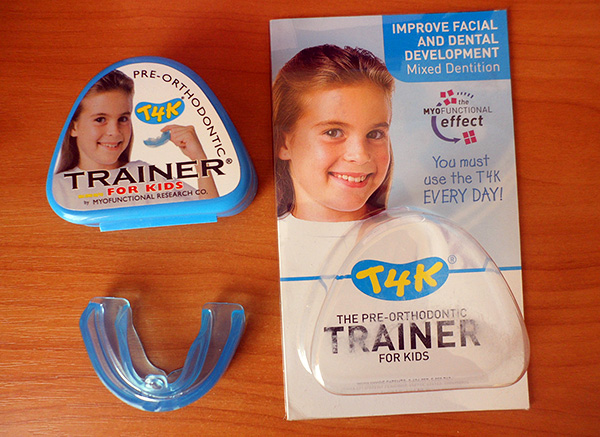
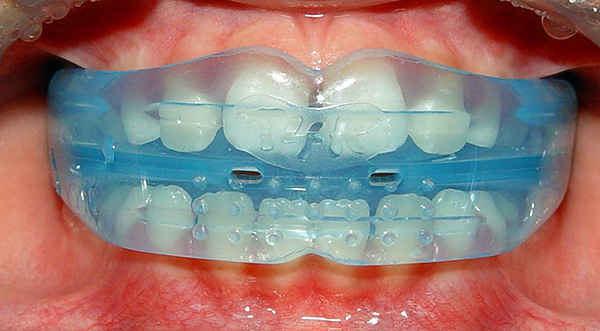
The mechanism of action of such a device for the normalization of bite is as follows:
- The device relaxes the muscles of the dental system and contributes to their proper restructuring in the presence of pathologies;
- Contributes to the elimination of bad habits (for example, the habit of sucking fingers is very harmful for bite habit);
- It prevents the laying of the tongue between the teeth (otherwise it would also cause a strong negative impact on the formation of bite in the child);
- Provides for limiting the growth of the upper jaw in the anterior region;
- Corrects the position of the language.
The standard age of a child to use an orthodontic trainer is from 2 to 5 years. The most frequent indications for use are Angle Class II anomalies (the so-called distal occlusion, when the teeth of the upper jaw are strongly pushed forward relative to the lower ones), especially with a tendency to open bite (that is, when the tooth rows cannot fully close - there is a gap between them).

In addition, the device can be used to correct the bite in children with complaints of pain in the temporomandibular joint (TMJ).
On a note
The mode of wearing orthodontic trainers is 2 hours during the day and all night. The first week is allowed to wear the device for 15-20 minutes a day, then take off. Gradually, wearing time increases, then you can try to fall asleep with a mouth guard. The child can spit it out reflexively in a dream - this is normal, and if you continue to use it, then gradually the child gets used.
Various modifications of trainers for the treatment of deep and open bite are also used in adults.
Medical removable devices for bite correction
There are a large number of varieties of removable orthodontic appliances used to treat bite abnormalities. The choice of a particular method of treatment depends on the specific clinical situation, the experience and skills of the doctor, as well as on the patient's readiness to comply with the doctor's prescriptions.

During the period of replaceable teeth bite, the treatment of occlusion anomalies is mainly aimed at modifying the growth of the jaws and creating favorable conditions for the eruption of permanent teeth. Expansion of the jaw lagging behind in growth can be achieved both on removable and fixed devices fixed in the mouth.
Next, we consider the most widely used constructions.
Passive nazubnye devices
The peculiarity of this group of orthodontic appliances is that the therapeutic effect is achieved through training the muscles of the maxillofacial area in combination with the forced extension of the jaws (or tongue) to the desired position.
To adjust the growth (expansion) of the upper jaw and align the teeth in the anterior section, for example, a plate on the upper jaw with expanding springs is used:
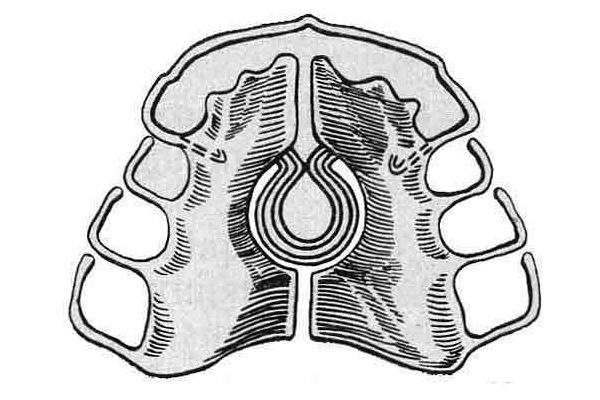
The device consists of:
- Lamellar basis;
- Springs in the middle;
- Support-holding elements - clasps;
- Metal arc on the front teeth.
The mechanism of action of such a plate:
- The expansion of the upper jaw in the anterior;
- Stimulation of the growth of the apical base of the upper jaw.
Age of use: temporary and replaceable teeth bite.
Also, a plate for the upper jaw with spring pushers is often used to position the desired position of individual teeth (for example, if the incisors of the upper jaw are behind the incisors of the lower jaw).
An example is shown in the photo below:

Mechanism of action:
- The plate allows you to tilt one or another tooth in the direction of the oral cavity;
- You can rotate the tooth around its axis at the desired angle;
- Also, the device allows you to move the front teeth in the direction of the oral cavity.
Deep abnormal bite, as a rule, is combined with pathologies in the lateral parts of the jaws (Class II and III occlusion, corresponding to the distal and mesial bite). To correct these pathologies, use of maxillary laminar devices.
For example, Klammt activator of the second or third type for the treatment of distal and mesial bite:
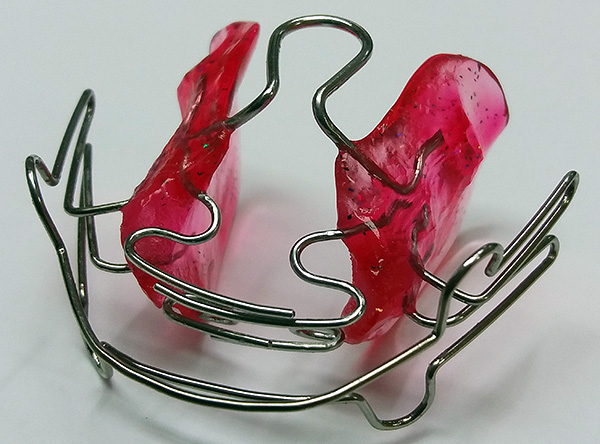
The design includes:
- Shield in the region of the posterior teeth for stretching and relaxing the soft tissues of the cheeks;
- Occlusal lining on the chewing surfaces of molars to divide the dentition;
- Palatine byugel - metal wire in the middle adjacent to the palate (to expand the upper jaw);
- Springs, prodragiruyuschie under the upper frontal teeth (spring force pushes the teeth forward);
- Arc to front teeth.
The mechanism of action of Klammt activator is due to the implementation of the following effects when wearing the device:
- The extension of the lower jaw;
- The inclination of the lower incisors toward the lip;
- Shortening of the anterior jaws;
- Lengthening of the lateral parts of the jaws.
Age indications: temporary, interchangeable and permanent bite (during active growth of the jaws). Contraindications to the use of this orthodontic apparatus is the absence of canines.
It is also worth noting the rather popular today two-maxillary detachable apparatus with paired blocks (the “Twin-block” apparatus):
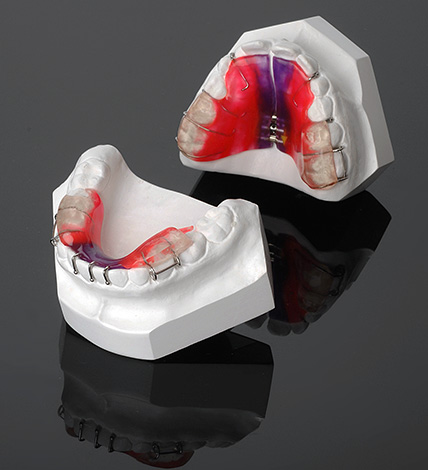
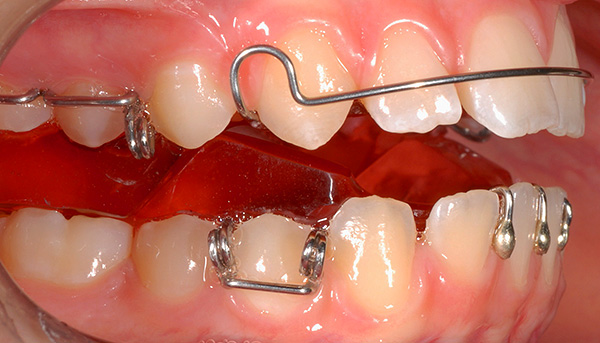
This design is popular among orthodontists both in Russia and abroad - the reason for such popularity is the rapid adaptation of the child to it. The device consists of two removable plates that fit to each other in the area of the side plates - this is the name of the device (paired plastic blocks are interconnected during use). Thus, there is a fixation of the lower jaw and its extension to the normal position. A special feature is that in the course of treatment the doctor can add plastic to increase the height of the linings.
Active tooth devices
Active tooth devices widely used for occlusion correction are plates that have an active screw for expanding the jaws,moreover, if necessary, the physician may add to the design also any elements inherent in the passive apparatus.

The screw is activated by the parents, or the child independently (with a special key, which is inserted into the holes in the screw drum).
On a note
If the child rubs the disc or there is a breakdown, then you need to try to get an appointment with a doctor as soon as possible. If you just stop using the device, it will quickly cease to be installed normally on the teeth. As a result, you will have to take pictures again and re-construct the structure. This is due to the fact that the child is growing rapidly, as a result of which the elements of the relief of the oral cavity are rapidly changing their pattern and size. It is important that such active growth is directed by the apparatus in the right direction in order to achieve maximum benefit for the future permanent bite.
Extraoral bite correction apparatus
Extraoral orthodontic devices for bite correction are a special kind of medical devices, having in their construction the following components:
- Special arc metal elements that are fixed in the holes on the orthodontic rings, previously fixed to the molars of the upper jaw;
- As well as crushing elastic power modules.
The extraoral devices can be used either independently for correction of occlusion anomalies, or as a preparatory stage for treatment on the bracket system, or during the active phase of treatment on the braces.
The strength elements and the parts fastening them are attached to the patient's face (neck, parietal-occipital region, forehead). Facial arc parts can be removed - the doctor teaches this child and parents.
For example, the photo below shows what the so-called chin slings look like:
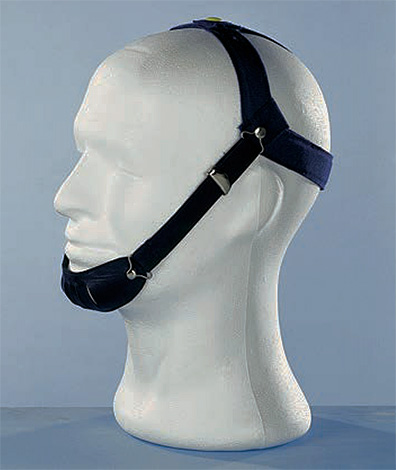
The design of the chin slings includes a pressure bandage made of thick fabric (or plastic), a head cap and connecting straps.
Indications for using such a device:
- Increased muscle tone, excessively pushing the lower jaw forward (that is, if there is a tendency to the formation of mesial bite);
- And also when the growth rate of the lower jaw prevails over the growth rate of the upper jaw;
Age of use of chin slings: interchangeable and permanent teeth bite.
Another type of extraoral orthodontic bite correction apparatus is a facial mask:

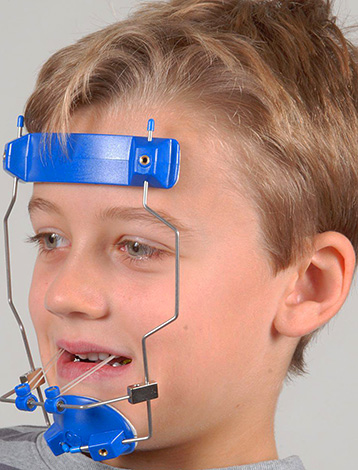
The design of the facial mask includes:
- Support plates (on the chin and forehead);
- Fixing screws;
- Metal carcass.
Mechanism of action:
- Traction of the upper jaw forward;
- The change in the vertical ratio of the front teeth.
Indications for use of orthodontic facial mask:
- Underdevelopment or posterior position of the upper jaw;
- Mesial bite due to the front position of the chin.
The facial mask is used to correct the bite in the period of temporary, interchangeable and emerging permanent bite (which corresponds to the age of the child 4-6 and 9-12 years old).
The following type of extraoral apparatus for correcting child bite in children is the orthodontic facial arch:
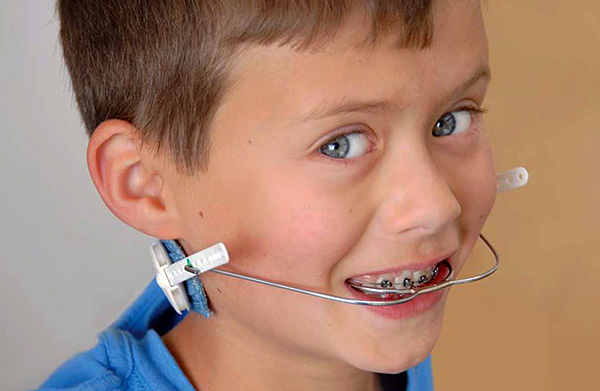
It consists of an intraoral nasal part, fixed in adapted tubes, and an extraoral front part, at the ends of which there are hooks for fixing the elastic thrust with a neck support.
The front arc is produced in three standard sizes - small, medium and large.
Thrust Direction Options:
- Occipital - the chin-type sling is fixed on the crown of the head;
- Cervical (with cervical support) - fixed to the back of the neck;
- Combined thrust.
Mechanism of action:
- Due to the facial arch, the growth of the upper jaw is delayed;
- Production of upper molars according to the 1st class of Angle is made (that is, in the optimal physiological position);
- The front teeth are tilted towards the mouth.
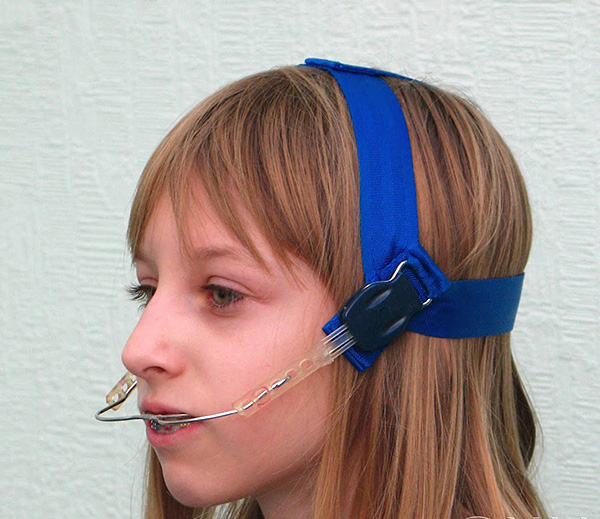
Clinical indications for use - the second class of occlusion of Angle (that is, the distal occlusion, when the teeth of the upper jaw are strongly advanced).
The age of use of the device is a replaceable and forming permanent bite.
The mode of wearing extraoral orthodontic appliances should ideally be 14-16 hours per day. The duration of treatment is from several months to a year or more.
It is interesting
With proper observance of the wearing of the out-of-the-box apparatuses, they are recognized as very effective, and in many cases their use allows avoiding the fixation of braces. In the US, children often go to school in the apparatus - this is considered quite normal and does not cause a negative reaction in people. In Russia, it is unlikely that it will be possible to meet children in such constructions on the face today.
Fixed bite correction structures
This group of devices includes various options for all known bracket systems, due to which gradual alignment of the bite occurs, as well as frame structures for the expansion of the jaws, which are fixed in the tooth rings on the molars.
Here it is worth mentioning separately the principles of self-help and diet when wearing braces.
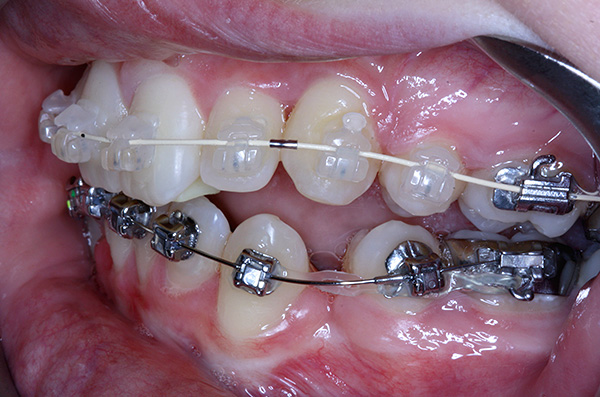
So, there are several problems that almost all patients with braces are faced with in one way or another:
- Starts to prick the arc, leaving the locks on the last teeth. This is due to the fact that the arc straightens over time to its original position, as the teeth occupy the right place. If this happens, you need to call the doctor and explain exactly what happened - the doctor will invite you to trim the ends of the arc. If there is no opportunity to quickly get to your doctor, you can temporarily close the tip of the arc with a special orthodontic wax. Such wax is sold in pharmacies, as well as in online stores;
- Doug is out of the last castle. In this case, you can try very carefully to fill the arc yourself with tweezers.Either use wax and seal this part of the arc so as not to injure your cheek before visiting the orthodontist;
- The braces come off. If possible, the braces should be preserved, informed to the orthodontist and, by agreeing on the time, come for gluing.
When wearing a bracket system, it is imperative that you follow special rules for eating: meat, apples and all tough products are cut into small pieces and gently chewed with side teeth. Eating off food can cause bracing to sticking. Gum, seeds, chocolate with nougat are completely excluded, as they can unglue the locks, or cause the arc to exit the lock.
Among the fixed orthodontic appliances for correcting bite is also the framework for the rapid expansion of the palatine suture:
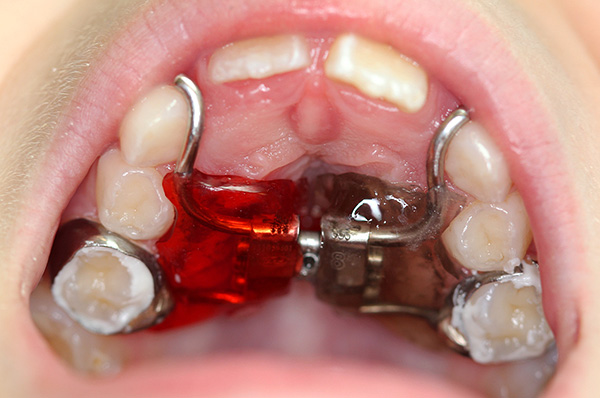
The design includes:
- Rings on the first molars and premolars (6 and 4 teeth);
- Rods;
- Screw for opening the palatal suture (it is activated by the child, or parents using the key).
The mechanism of action of the device is implemented by:
- Disclosure of the palatal suture;
- Extensions of the upper dentition;
- Shortening of the anterior upper dentition.
The age of application of the orthodontic framework for the expansion of the palatal suture is a replaceable and permanent bite.
Indications for use - I, II, III class according to Engle, as well as congenital malformations of the maxillofacial area with a narrowing of the dentition by more than 5 mm.
Another fixed device - quadrohelix:
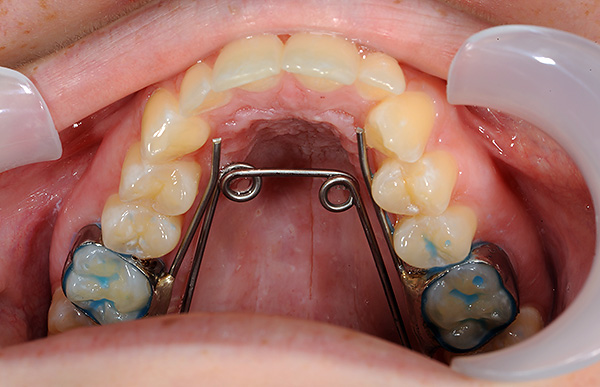
Very effective for slow palatal expansion of the upper jaw. The skeleton can be adjusted to get a larger expansion in the front section of the dentition. The activation is made by the doctor.
Also worth mentioning is the palatine byugel:
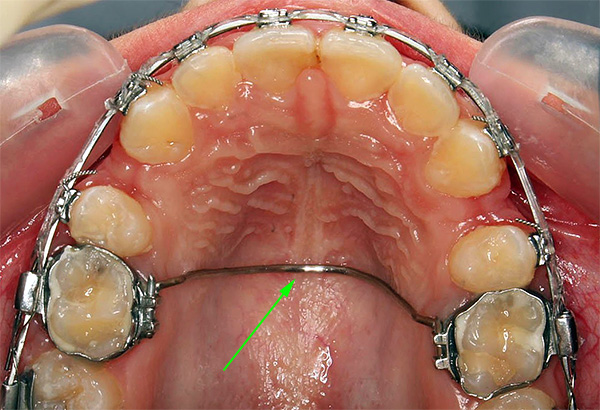
It is used to adjust the shape of the dental arch and prevent unwanted movement of the molars.
All frame products are fixed on the dental cement to the abutment teeth.
On the use of retention apparatus
Retention apparatuses are used at the end of orthodontic treatment to preserve the achieved bite. The fact is that soft tissues and ligaments tend to return to their usual position, and accordingly, the teeth, under the influence of surrounding tissues, can also take their former pathological position.
As retention can be used the above-mentioned therapeutic devices, which are no longer activated.
Or, retention caps are used, made after removing the braces on the final impression of the patient's teeth:
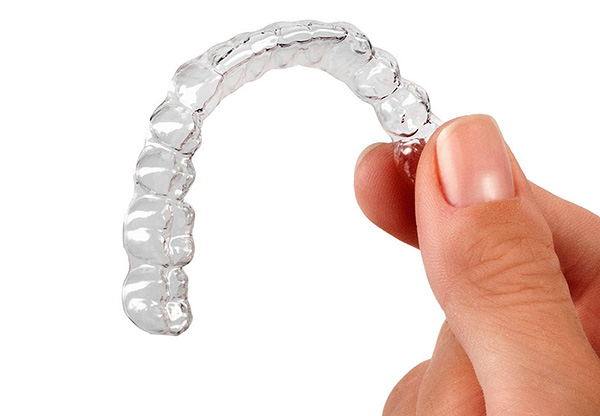
The first 3-6 months such caps should be worn as long as possible, removing only during meals.You can then switch to wearing mode only at night.
On a note
In retention caps it is not recommended to drink coffee, tea, wine, as well as smoke, because plastic caps can be colored and lose their transparency.
After the stage of wearing braces, a metal retainer is often used. This simple orthodontic apparatus is a wire twisted several times, which is fixed from the lingual and palatal side of the first six teeth to a filling material:

It is important to know
If you feel that the retainer has come loose from the tooth or from several teeth at once, you need to call your orthodontist and glue the construction as soon as possible, because the teeth can quickly change their position.
Depending on the clinical situation, each doctor chooses the orthodontic structure, which, in his opinion, will be most effective given in a particular case. And in many ways, the success of treatment depends on the patient himself - on his discipline and the correct observance of all the recommendations of the orthodontist.
If you have personal experience of using certain orthodontic appliances for bite correction, be sure to share the information by leaving your review at the bottom of this page (in the comments box).
What is important to know about the correction of bite in children
Useful video: is it possible to correct the bite without plates and braces?



